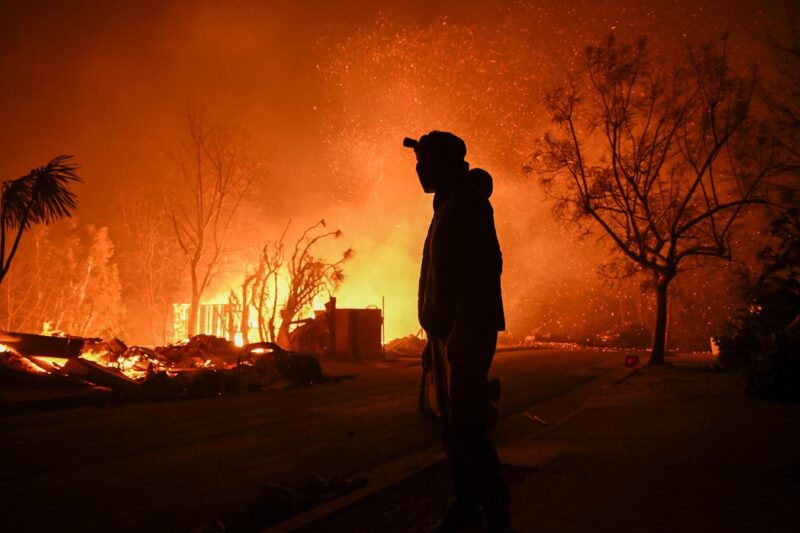CALIFORNIA, UNITED STATES – JANUARY 8: A house in on fire as residents try to escape the site in Pacific Palisades, California, Los Angeles, United States on January 8, 2025. A fast-moving wildfire has forced 30,000 people to evacuate, with officials warning that worsening winds could further escalate the blaze. (Photo by Tayfun Coskun/Anadolu via Getty Images)
Anadolu via Getty Images
The growing evidence base around how wildfires both are being exacerbated by climate change, which is in turn leading to more frequent and severe wildfires, was highlighted by a recent analysis.
According to the State of the Wildfires report, extreme fires will become more common due to the warming that has already been committed through greenhouse gas emissions.
The study also found between March 2024 and February 2025, fires scorched about 3.7 million square kilometres worldwide and emitted over 8 billion tonnes of carbon dioxide into the atmosphere.
Clean Air Fund chief executive Jane Burston said there is a “vicious circle”, where climate change creates an increased risk of wildfires, which then increases the impact of climate change, in an interview.
Burston added climate change obviously makes wildfires more frequent and more intense, and burning trees releases carbon dioxide and pollutants like black carbon into the atmosphere, which then intensifies heat waves and alters weather patterns.
“There’s a feedback loop with tropospheric ozone and climate change,” she told me. “Wildfires emit carbon monoxide and nitrogen oxides, which precursors ozone.
“And ozone is itself a greenhouse gas causing global warming.”
Burston said wildfires in Eastern Siberia have been linked to elevated black carbon levels in the Arctic between 2019 and 2021, which is causing the ice to melt, which in turn raises sea levels.
She added black carbon from Amazonian wildfires has been estimated to increase glacial melting in that region of the world by 3% to 4%.
Burston said the Clean Air Fund is involved in a project in Bogota, Colombia where wildfires are increasingly happening within the city boundaries.
The Clean Air Fund are supporting the local authorities to integrate forest fire management into their air quality plan, so there can be much faster and more comprehensive emergency responses.
She added they are also supporting Bogota with examples of international and national best practice for the prevention of fires, the management of fires and wider monitoring, so that they can determine what they want to include in their plans.
“Super pollutants as a group are responsible for about half of the global warming which we have already experienced, but they do not stay in the atmosphere for very long,” said Burston.
“The quicker you can tackle them and stop them being in the atmosphere, the faster the implications will be for climate change mitigation.”
The chief executive of IQAir North America, Glory Dolphin Hammes the reach of wildfire smoke is surprisingly vast, in an email.
Hammes added air pollution from fires in the Amazon rain forest in South America have has been detected as far north as Alaska, and as far distant as Asia on the other side of the world.
She said wildfires often generate high concentrations of black carbon and ground-level ozone, both of which have severe health impacts.
Hammes added wildfires also emit volatile organic compounds (VOCs) and nitrogen oxides (NOx), which react in sunlight to form ground-level ozone.
“As wildfires grow more frequent and severe due to climate change, they are fuelling a dangerous feedback loop.
“Hotter, drier conditions lead to more fires, which release more black carbon and ozone precursors, worsening both air quality and the climate crisis,” said Hammes.
She added improving toxic air requires a combination of immediate mitigation and long-term systemic change.
Hammes said successful strategies so far have focused on reducing emissions at their source, transitioning away from fossil fuels toward clean energy, enforcing stricter vehicle and industrial emissions standards, and controlling agricultural and waste burning.
In addition, technologies like air filtration systems, cleaner cookstoves, and hyperlocal real-time air quality monitoring have helped protect communities and guide policy decisions.
“Scaling these solutions globally requires coordinated action: stronger environmental policies, investment in renewable energy, and equitable access to clean air technologies, especially in marginalized and low-income regions most affected by climate change and air pollution,” said Hammes.









